Huawei OceanStor Pacific Storage and Dalet Media solution Interoperability Test Report
Interoperability Test Report

Axians Global
All Rights Reserved
Report Summary
Project Name | Huawei OceanStor Pacific Storage and Dalet Media solution Interoperability Test Report |
Tested sample and quantity | OceanStor Pacific distributed storage, 1 set |
Test Category | Interoperability Test |
Test Date | June, 2025 |
Test Item | Function test, compatibility test, reliability test, TV program service performance UHD service adaptability test, and maintainability test |
Test conclusion | Based on the requirements in the Test Basis and Reference Basis columns, the Dalet Galaxy MAM and Huawei OceanStor Pacific series distributed storage systems have tested the functions, performance, reliability, and serviceability of test items. The test result of the storage system meets the requirements of the industry standards. |
Remarks | For details about the test results. |
1. Environment Configuration
1.1 Typical network topology


Service switch
Storage node
Test client 1
………
Test Client n


Back-end switch
Description:
10GE/25GE optical fiber;
10GE/25GE switches correspond to 40GE stack cables, and 25GE/40GE/100GE switches correspond to 100GE stack cables.
Fig. 1-1 Typical network topology
According to Figure 1-1, the test devices are deployed for this test. The test networking diagram is as follows:
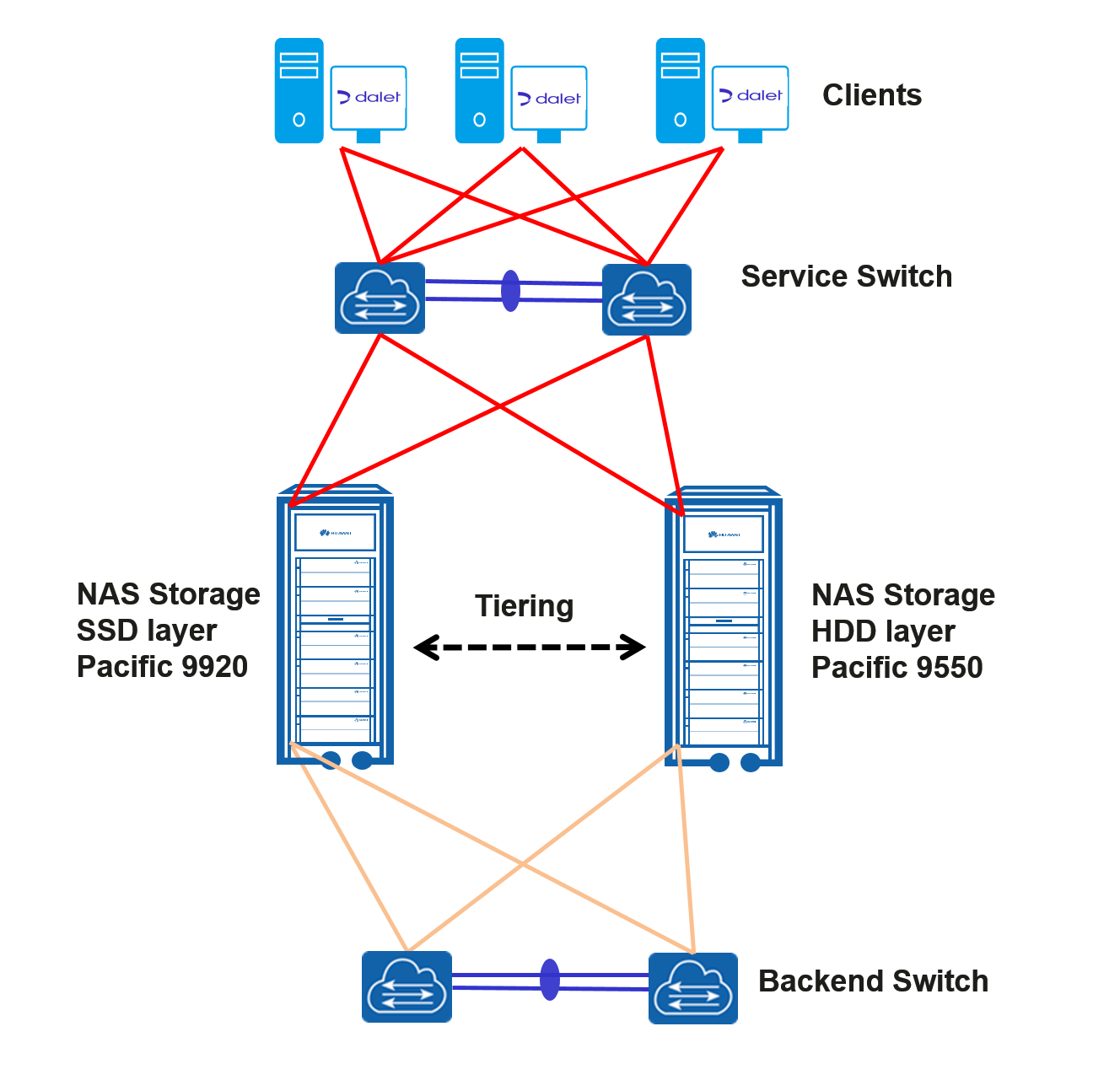
Figure 1-2 Test network diagram
Networking description:
- Windows workstation: A workstation is mounted to a storage node and uses the NLE software on each workstation to read video data from the storage.
- Linux client: Mount the storage node on the client and run the storage test tool.
- OceanStor Pacific storage node: In the OceanStor Pacific environment, a namespace is created and shared with Windows workstations.
1.2 Hardware and software configuration
1.2.1 OceanStor Pacific Node Configuration
Table 1 Storage configuration table
Name | Description | Quantity |
OceanStor Pacific storage node | OceanStor Pacific 9920 2U x 3nodes + OceanStor Pacific 9550 5U x 2 Chassis | 1 set |
1.2.2 Hardware Configuration and Test Software
Table 2 Hardware configuration
Name | Description | Vendors | Quantity |
PC | Intel core i9-14900K with Nvidia GeForce 3080 Ti – 128 GB of RAM | ASUS | 2 Set |
Workstation | HP Z8-G4 | HP | 1 Set |
Table 3 Test software and tools
Software name | Description | Quantity |
Dalet Xtend | Dalet Plugin for Adobe Premier to import Videos | 1 Set |
Adobe Premier | Video Editing Software | 1 set |
Dalet Galaxy | Dalet Media Asset Management Software | 1 set |
S3Browser | S3 Browser is a freeware Windows client for S3. | 1 set |
2. Test Case
2.1 Function test
2.1.1 Protocol Interconnection
Test Purpose | Verify that Windows workstations can connect to storage clusters using CIFS. |
Test Networking | Networking diagram for basic verification |
Prerequisite |
|
Test Procedure | Dalet Galaxy uses CIFS to mount storage shares. |
Expected Result | The storage shared space is successfully mounted to the Dalet Galaxy, the storage space size can be viewed, and the mounting directory can be opened. |
Test result | 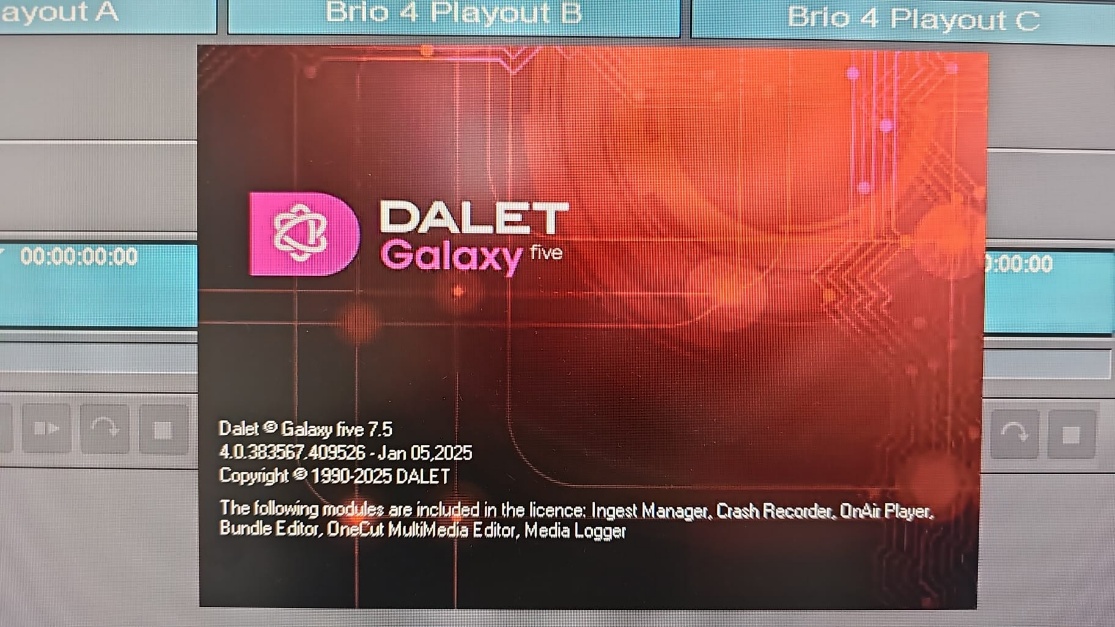 ° °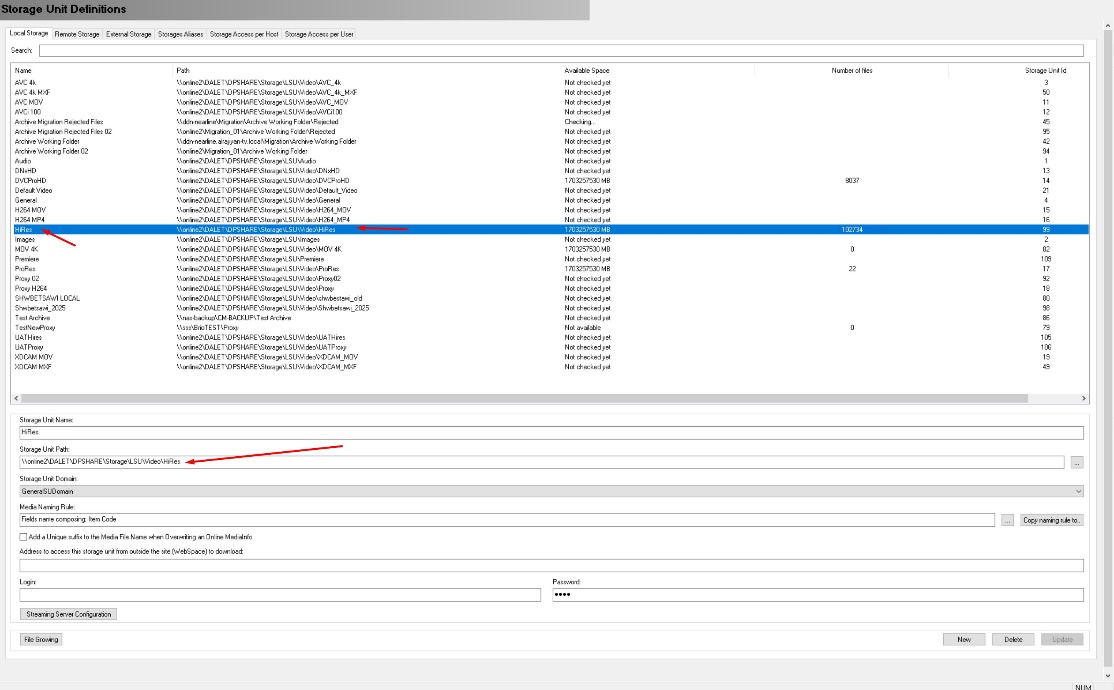 The shares successfully mounted using the proper credentials. |
Test conclusion | Successful |
Remarks |
2.1.2 Linking and Playing Materials
Test Purpose | To verify that the stored material can be linked in Dalet Galaxy and can be played properly. |
Test Networking | Networking diagram for basic verification |
Prerequisite | 1. The Dalet Galaxy and OceanStor Pacific storage cluster have been installed. 2. The file service has been enabled and materials have been stored in the storage cluster. 3. The Pacific shared directory has been mounted to the workstation. |
Test Procedure | View the live video image quality. |
Expected Result | The live video is smooth without frame loss or frame freezing. |
Test result | 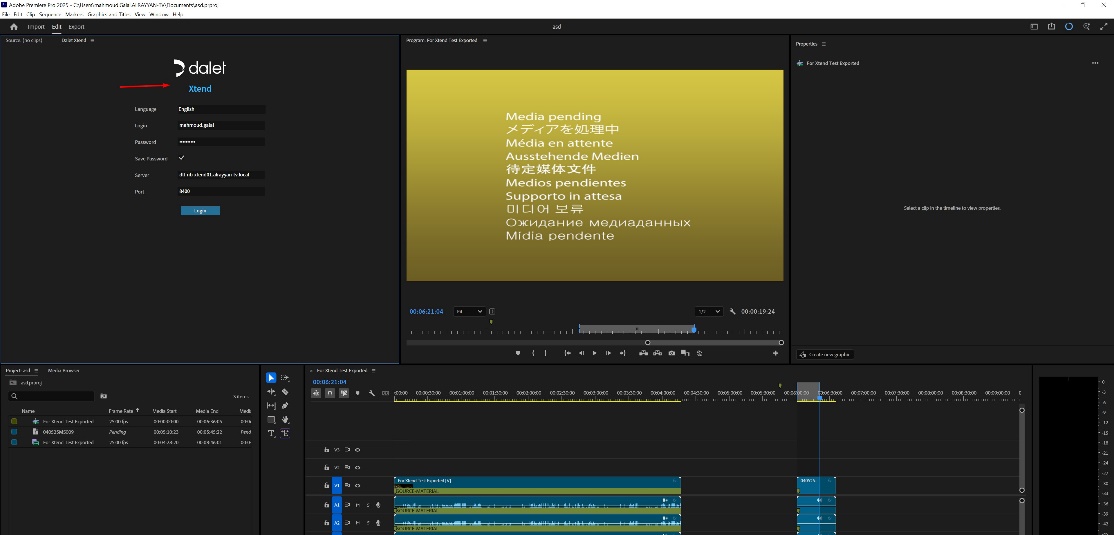 Live video is transferred and can be browsed |
Test Conclusion | Successful |
Remarks |
2.1.3 Importing and Playing Materials
Test Purpose | To verify that materials can be imported to the Dalet Galaxy and can be played properly. |
Test Networking | Networking diagram for basic verification |
Prerequisite | 1. The Dalet Galaxy and OceanStor Pacific storage cluster have been installed. 2. The file service has been enabled and materials have been stored in the storage cluster. 3. The Pacific shared directory has been mounted to the workstation. |
Test Procedure | View the live video quality. |
Expected Result | The import is successful. The live video is smooth without frame loss or frame freezing. |
Test result | 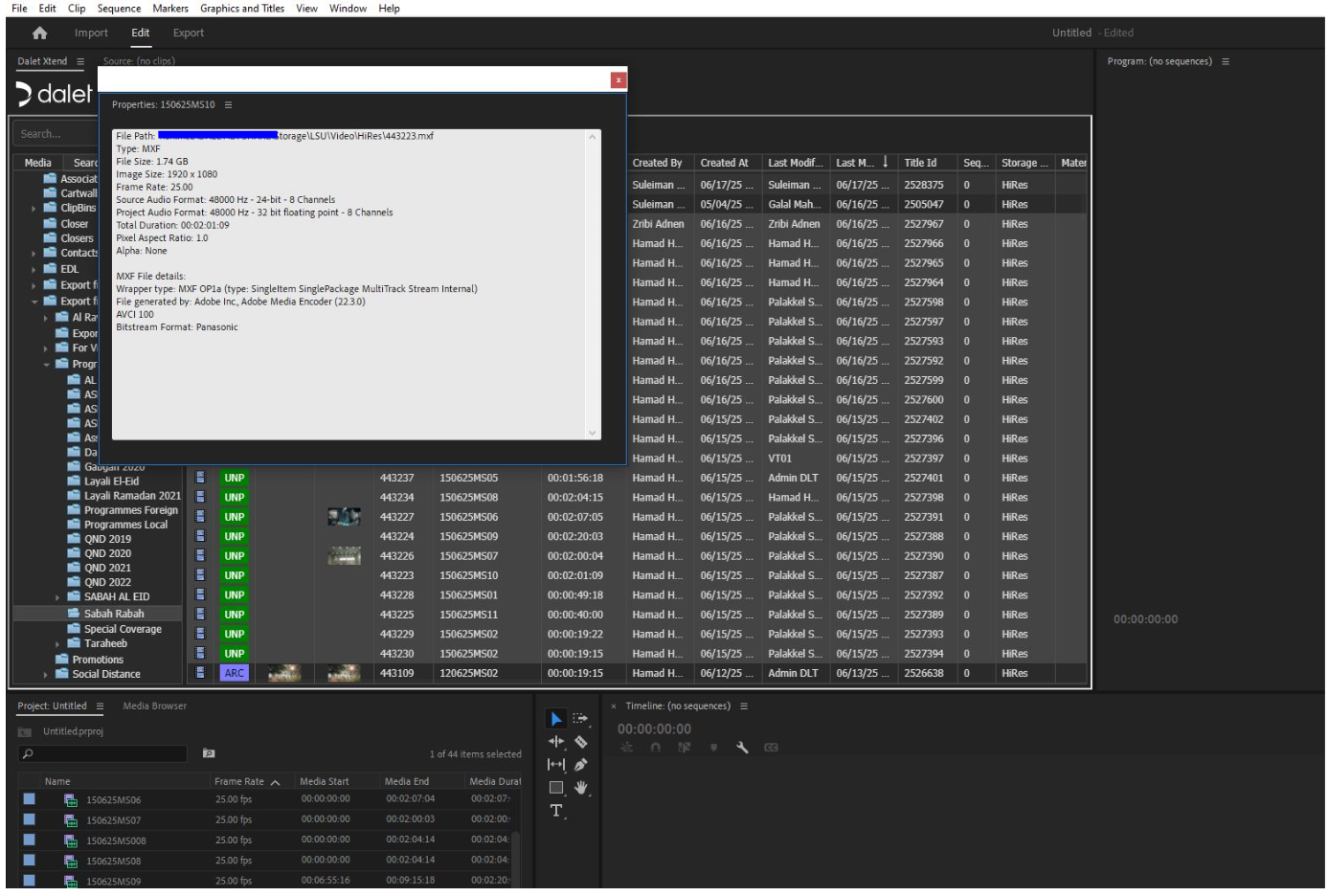
Live video is smooth without frame loss or frame freezing. |
Test conclusion | Successful |
Remarks |
2.1.4 Video Clip Function
Test Purpose | To verify the function of editing a Dalet Galaxy video clip. |
Test Networking | Networking diagram for basic verification |
Prerequisite | 1. The Dalet Galaxy and OceanStor Pacific storage cluster have been installed. 2. The file service has been enabled and materials have been stored in the storage cluster. 3. The Pacific shared directory has been mounted to the workstation. 4. The material has been added to the material drawer. |
Test Procedure | 1. Create a video sequence and drag material A to the sequence. 2. Insert the clip of material B into the video sequence. |
Expected Result | Material clip is inserted successfully and played normally. |
Test result | 1. Create a video sequence and drag material A to the sequence successfully.  2. Insert the clip of material B into the video sequence successfully.  |
Test conclusion | Successful |
Remarks |
2.1.5 Insert Special Effects Function
Test Purpose | To verify the function of inserting special effects into the Dalet Galaxy. |
Test Networking | Networking diagram for basic verification |
Prerequisite | 1. The Dalet Galaxy and OceanStor Pacific storage cluster have been installed. 2. The file service has been enabled and materials have been stored in the storage cluster. 3. The Pacific shared directory has been mounted to the workstation. 4. The material has been added to the material drawer. |
Test Procedure | 1. Add PIP effects and play |
Expected Result | 1. The special effect is added successfully and the playback is smooth.  |
Test result | Special effect is added successfully, and the playback is smooth |
Test conclusion | Successful |
Remarks |
2.1.6 Exporting Videos
Test Purpose | To verify the function of exporting Dalet Galaxy videos to the storage device. |
Test Networking | Networking diagram for basic verification |
Prerequisite | 1. The Dalet Galaxy and OceanStor Pacific storage cluster have been installed. 2. The file service has been enabled and materials have been stored in the storage cluster. 3. The Pacific shared directory has been mounted to the workstation. |
Test Procedure | 1. Export the clipped video to the shared directory. |
Expected Result | 1. The export is successful and the playback is normal. 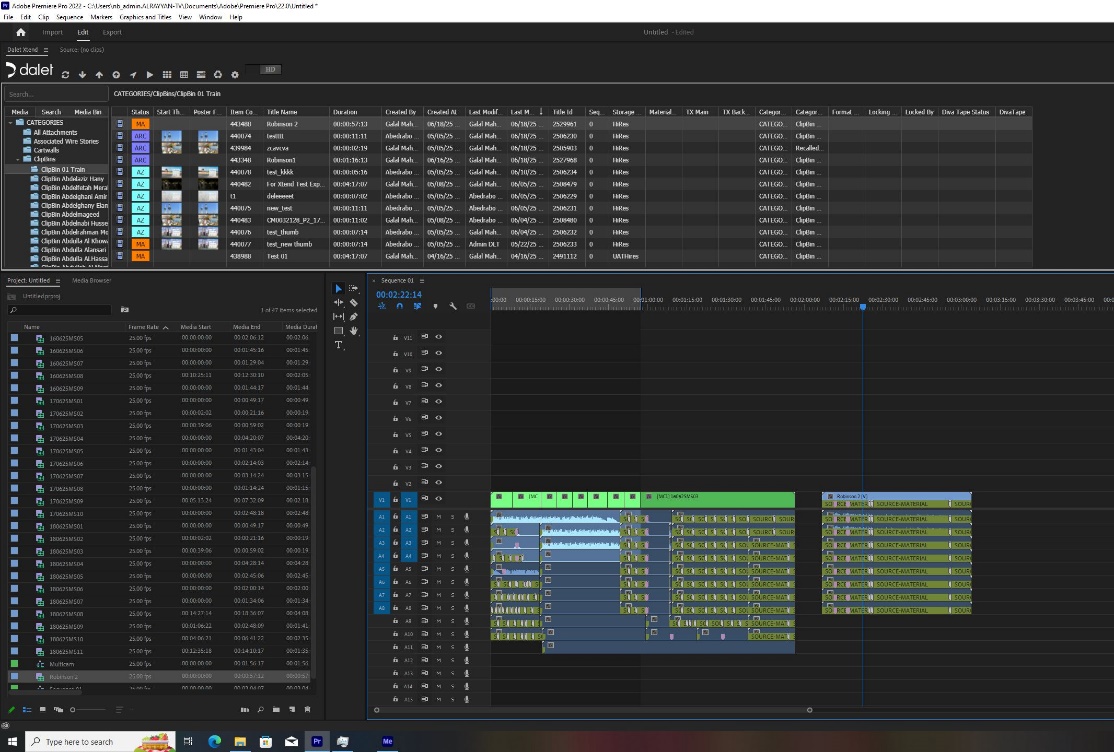 |
Test result | Export is successful and the playback is normal. |
Conclusion | Successful |
Remarks |
2.1.7 « Offset Read » function test
Test Purpose | The storage system supports the ability to read audio or video separately. The actual traffic bandwidth of the storage system should be the bandwidth of the audio or video alone. |
Test Networking | Networking diagram for basic verification |
Prerequisite | 1. Set up the test environment according to the test network diagram. 2. To test the function of configuring the 4K non-line editing software on the client. (For example, the 4K ultra-HD bit rate is 500 Mbit/s, that is, 62.5 MB/s.) and mount the storage system shared directory. 3. 50% of the storage space is used. |
Test Procedure | 1. Introduce two channels of UHD audio and video into the NLE software system on the test client. For example, the 4K ultra-HD bit rate is 500 Mbit/s, that is, 62.5 MB/s. 2. Delete the first channel of video, delete the second channel of audio, and play the first channel of audio and the second channel of video. 3. Check whether the client bandwidth is the bandwidth required by one channel of audio and video. (One 4K ultra-HD bit rate v = 500 Mbit/s) |
Expected Result |
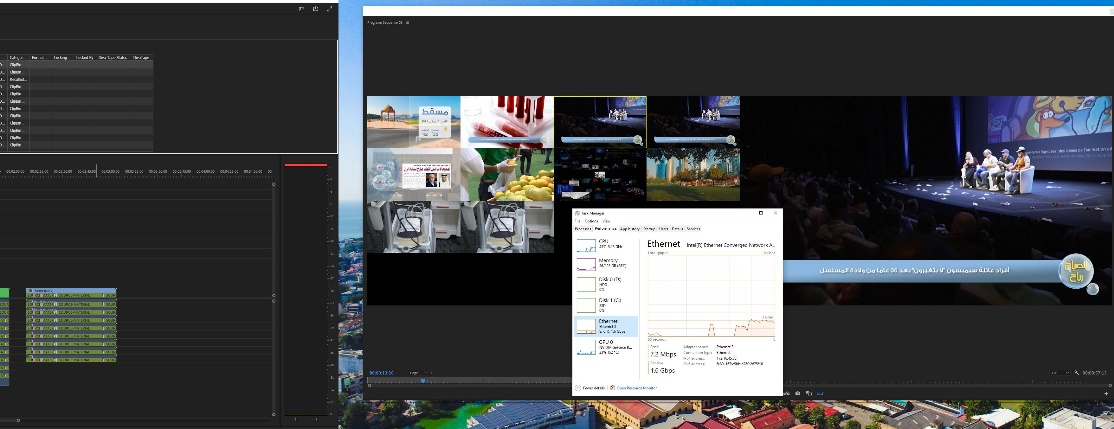 |
Test result | The storage system supports the capability of reading audio or video separately. The actual traffic bandwidth of the storage system must be the bandwidth of the audio or video separately. |
Test conclusion | Successful |
Remarks |
2.1.8 Object function test
Test Purpose | Verify that the Object support archiving by Dalet. |
Test Networking | Basic Verification Networking |
Prerequisite | A bucket has been created on the storage device, and bucket can access by Dalet. |
Test Procedure | 1. Configure the bucket information to Dalet Software. 2. Run archiving operation in Dalet to Object above bucket. |
Expected Result | 1. Connection build successfully. 2. Archiving operation done successfully. |
Test result | In step 1, the bucket is successfully connected. 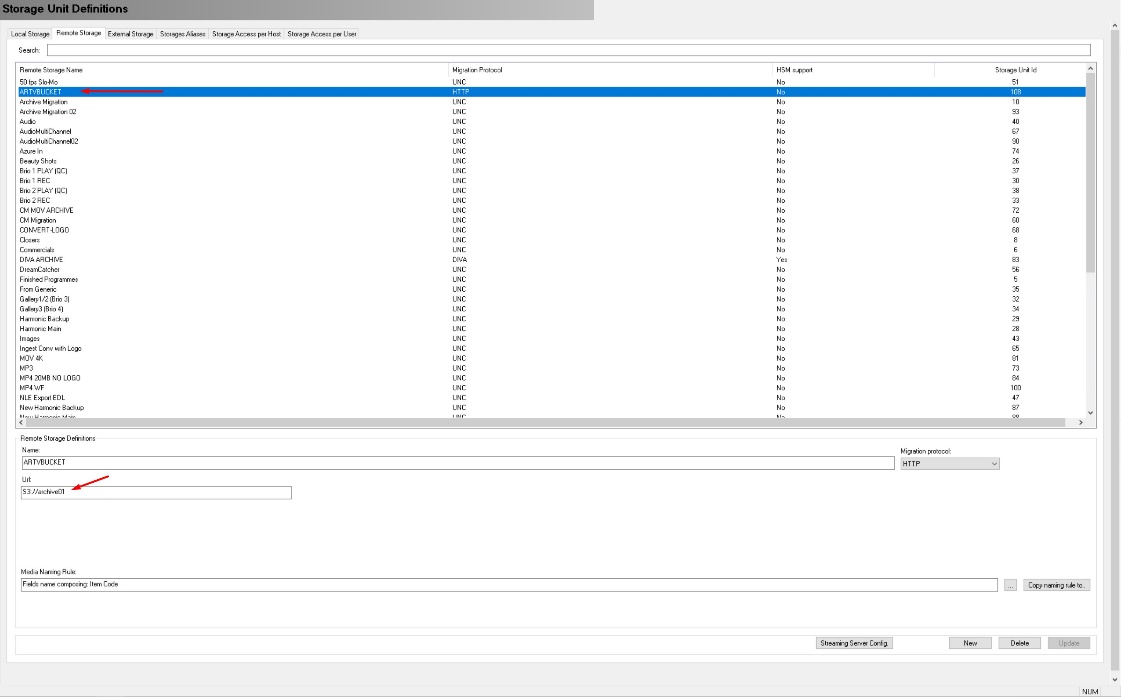 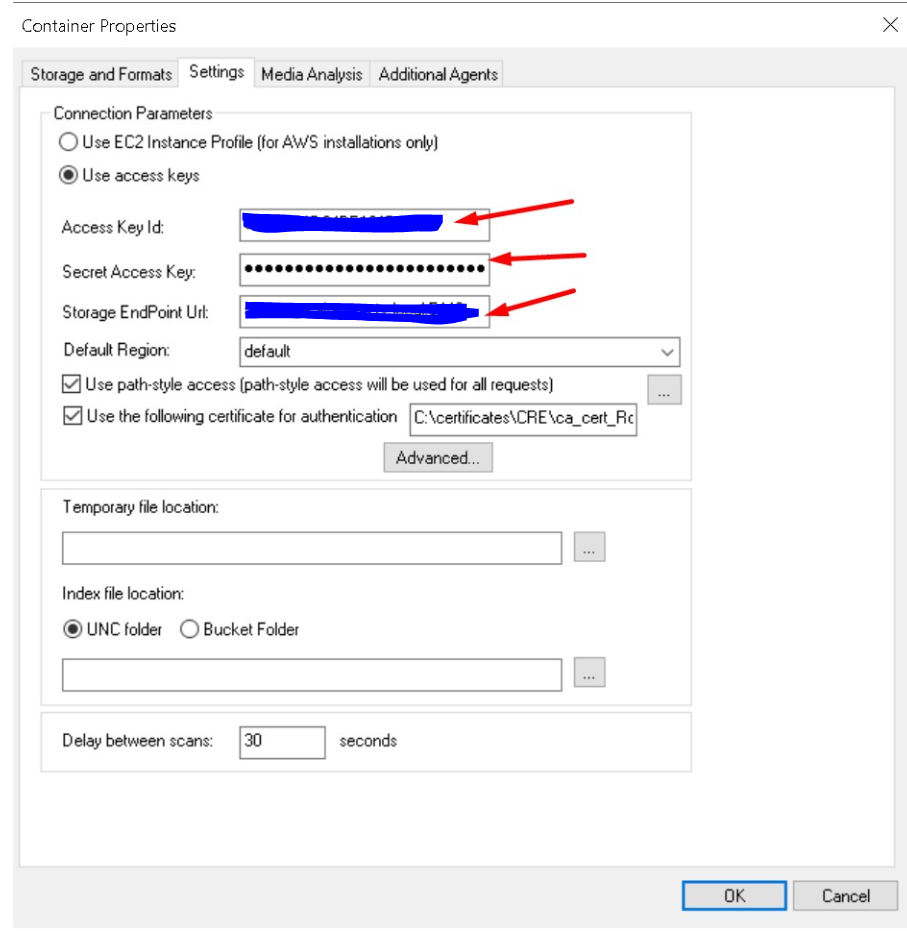 In step 2, the operation is done successfully. 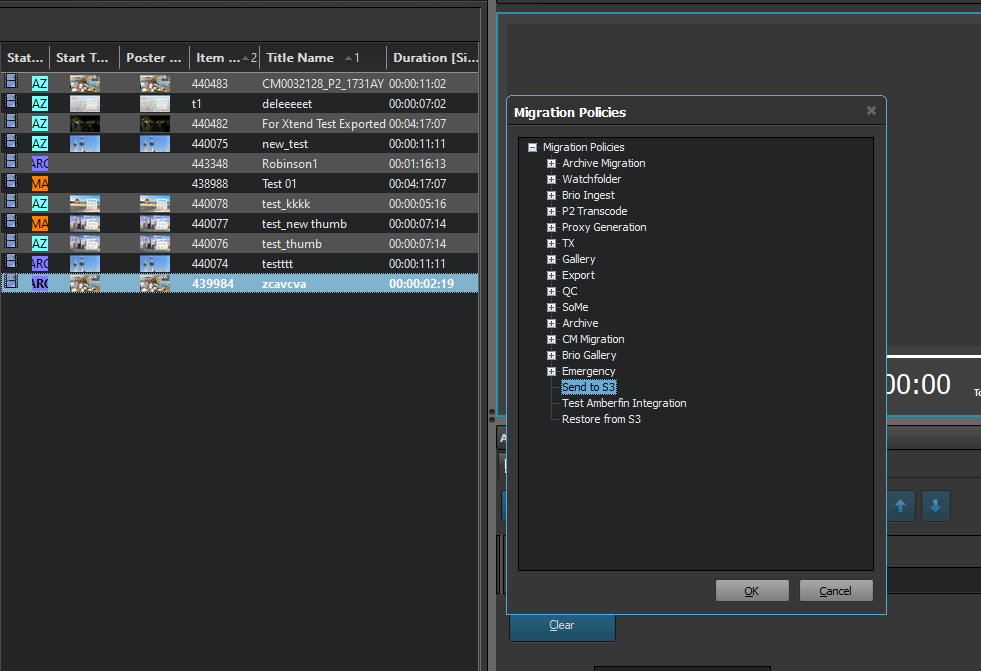 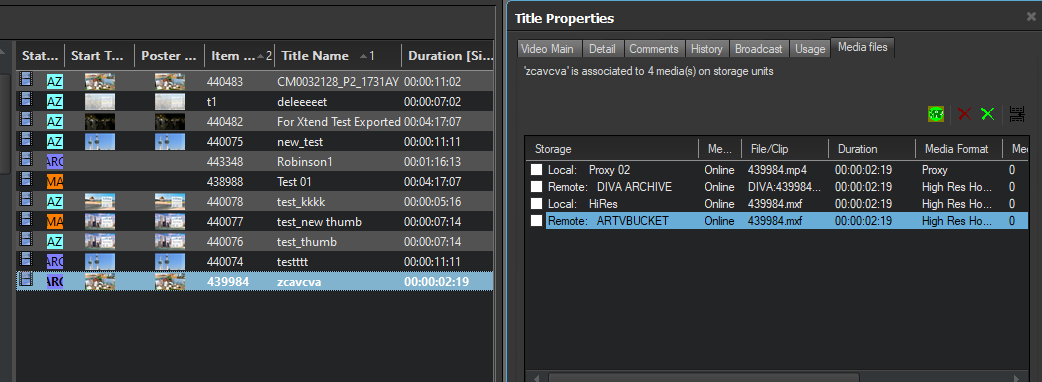  |
Test conclusion | Successful |
Remarks | The Pacific object storage is successful configured on Dalet and can migrate file to S3 in Dalet. |
2.1.9 SmartInterworking – File and Object Interworking
Test Purpose | Verify that the storage system supports SmartInterworking (file and object access each other). |
Test Networking | Basic Verification Networking |
Prerequisite | 1. The storage system is running properly. 2. The file and object have been initialized on DeviceManager. Multi-Protocol hosts have been prepared. |
Test Procedure | 1. Create a namespace on DeviceManager. 2. Configure the CIFS, and object for the namespace. 3. Mount a shared directory to the Windows hosts using CIFS, respectively. 4. Wait until the Windows host creates a file in the CIFS shared directory and writes data to the file, and the object host uploads a file using the S3 protocol. 5. View the files on the protocol hosts. |
Expected Result | 1. In step 3, the shared directory is mounted to the Windows hosts using CIFS. 2. In step 4, operations on all protocol hosts are successful. 3. In step 5, all files are listed successfully and can be viewed on all protocol hosts. |
Test result | 1. In step 3, the shared directory is mounted to the Windows hosts using CIFS. 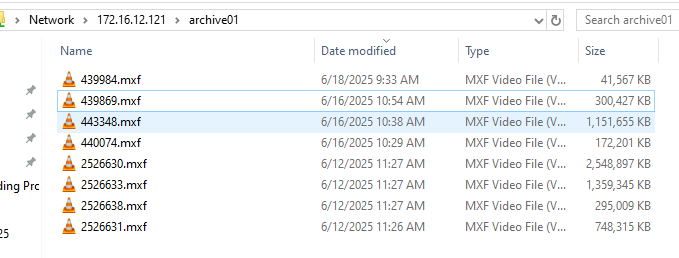 2. In step 4, operations on all protocol hosts are successful. 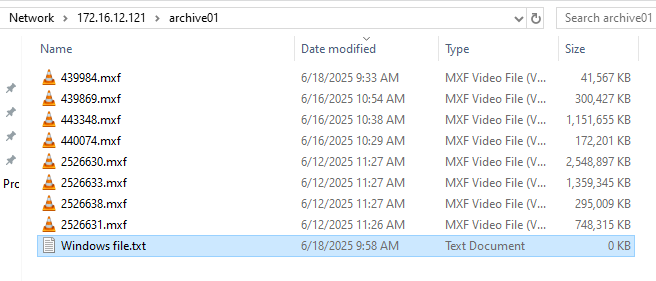 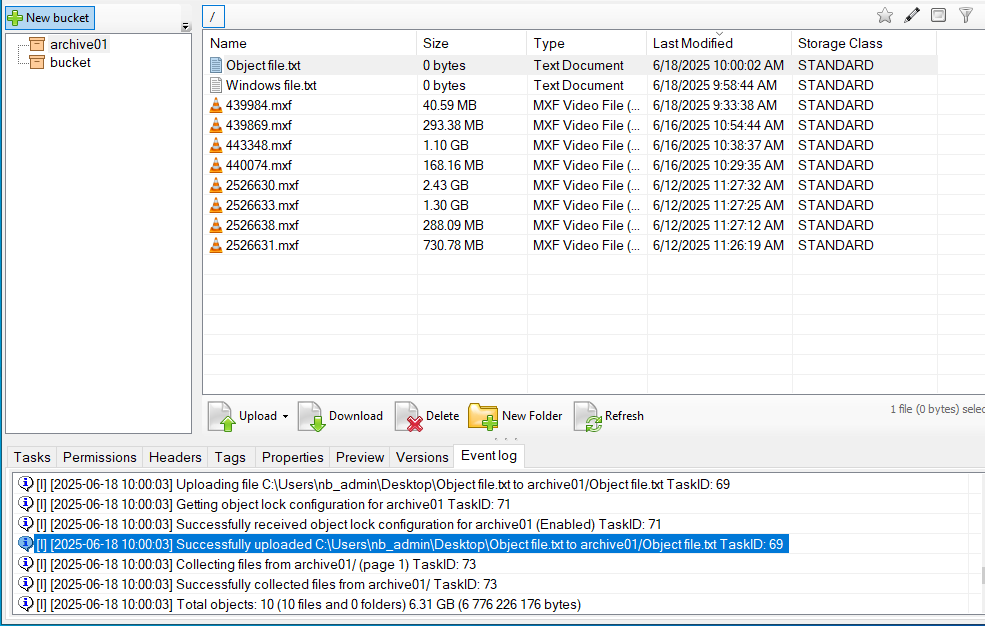 3. In step 5, all files are listed successfully and can be viewed on all protocol hosts. 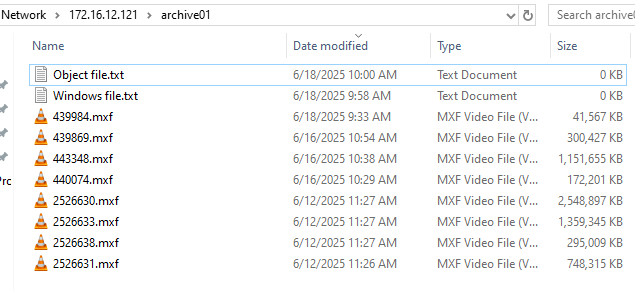 |
Test conclusion | Successful |
Remarks | All the files write from NFS protocol or S3 protocol, can list in both sides. |
2.1.10 Recycle Bin function test
Test Purpose | Verify that the storage system supports the recycle bin function. The recycle bin function prevents data loss caused by mistaken account deletion. Deleted data can be restored from the recycle bin. |
Test Networking | Basic Verification Networking |
Prerequisite | 1. The storage system is running properly. 2. The object service has been initialized on DeviceManager. 3. An object protocol host has been prepared. |
Test Procedure | 1. Create an account and a namespace on DeviceManager. 2. On DeviceManager, enable the recycle bin function for the namespace. 3. Use the S3 API test tool to upload object “test” to the namespace and record the MD5 value of the object. 4. Delete object test from the namespace. 5. After the deletion is complete, list objects in the namespace. 6. Copy the object from the recycle bin to the namespace, rename the object as “test2”, and compare the MD5 values of objects “test” and “test2”. |
Expected Result | 1. In step 2, the recycle bin function is enabled and the retention period is set successfully. 2. In step 3, the object is uploaded successfully. 3. In step 4, the object is deleted successfully. 4. In step 5, the objects are listed successfully and you can view the object data in the recycle bin. 5. In step 6, the object is copied successfully, and its MD5 value is the same as that of object test. |
Test result | 1. In step 2, the recycle bin function is enabled and the retention period is set successfully. 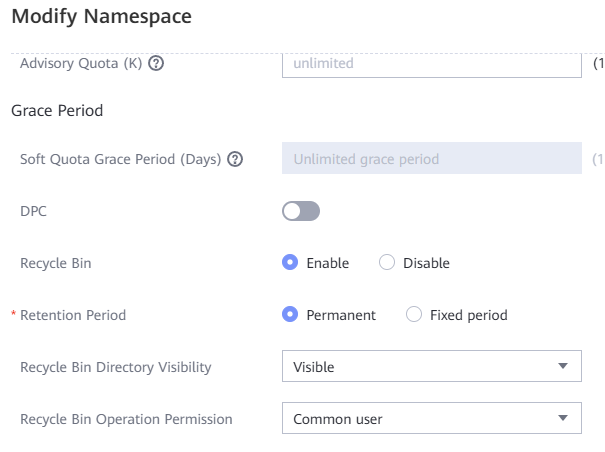 2. In step 3, the object is uploaded successfully. 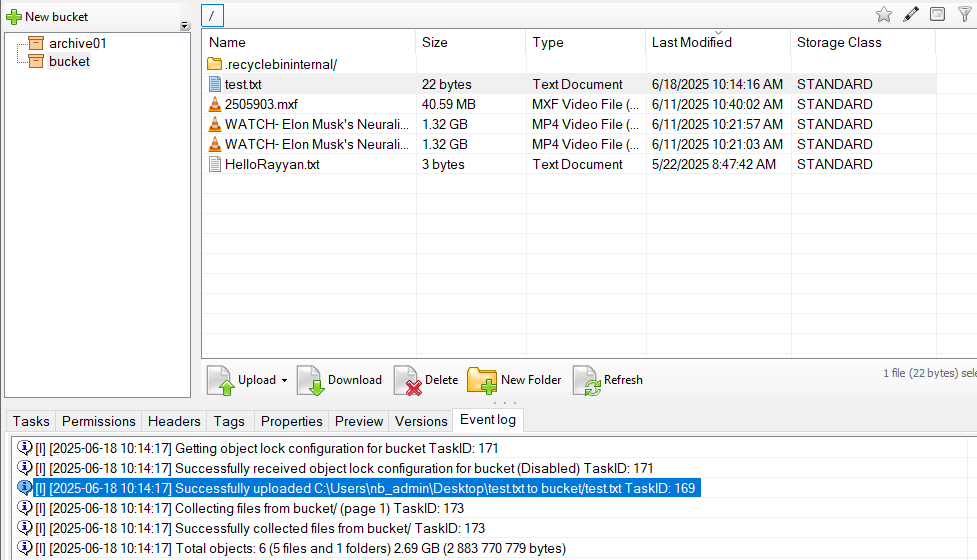 3. In step 4, the object is deleted successfully. 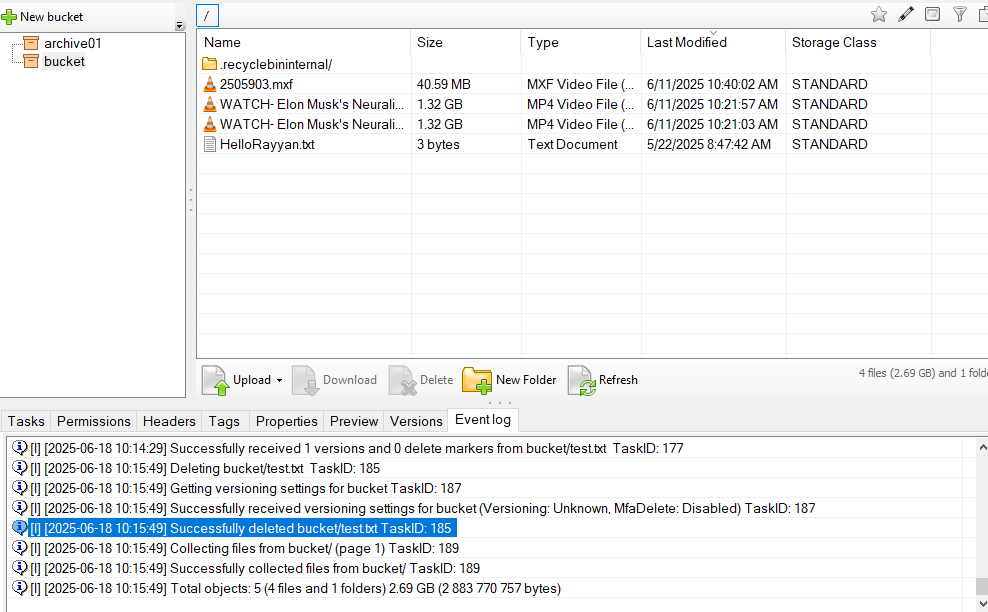 4. In step 5, the objects are listed successfully and you can view the object data in the recycle bin. 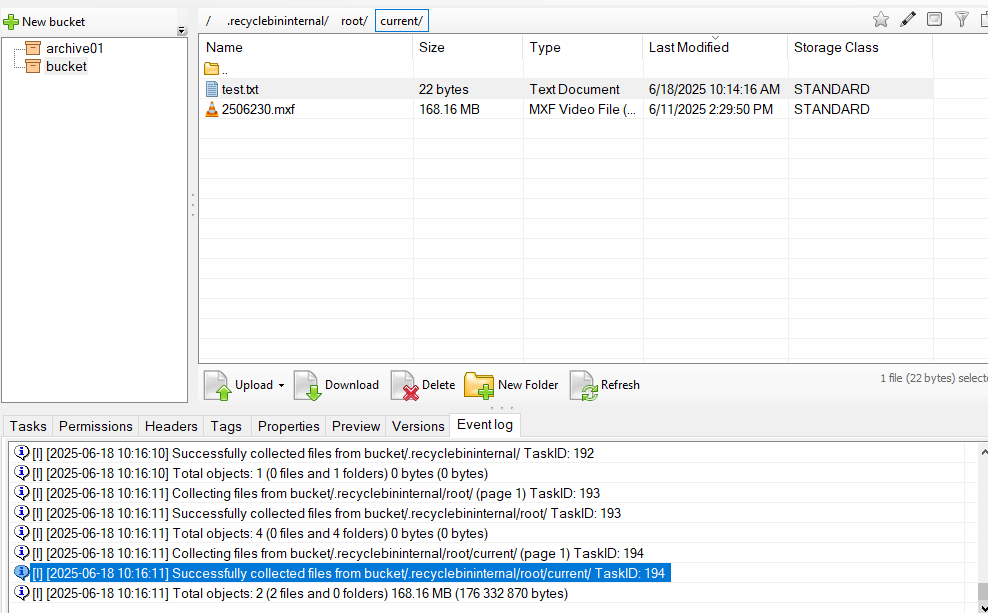 5. In step 6, the object is copied successfully, and its MD5 value is the same as that of object test.  |
Test conclusion | Successful |
Remarks | The object in Pacific, if delete by mistake still can restored from the recycle bin. |
2.1.11 Object Lock (WORM) function test
Test Purpose | Verify that the object service supports the WORM function. |
Test Networking | Basic Verification Networking |
Prerequisite | 1. The storage system is running properly. 2. The object service has been initialized on DeviceManager. 3. An object protocol host has been prepared. 4. Test account version has been created and its AK has been recorded. |
Test Procedure | 1. Create bucket and enable worm. 2. Modify/Delete file on S3 client. |
Expected Result | 1. In step 1, the bucket is created, and worm enabled successfully. 2. In step 2, the file fails to delete and modify. |
Test result | 1. In step 1, the bucket is created, and worm enabled successfully, the worm waiting time is 1 hour, the data update time in 1 hour can delete or change, after 1 hour cannot delete or change. 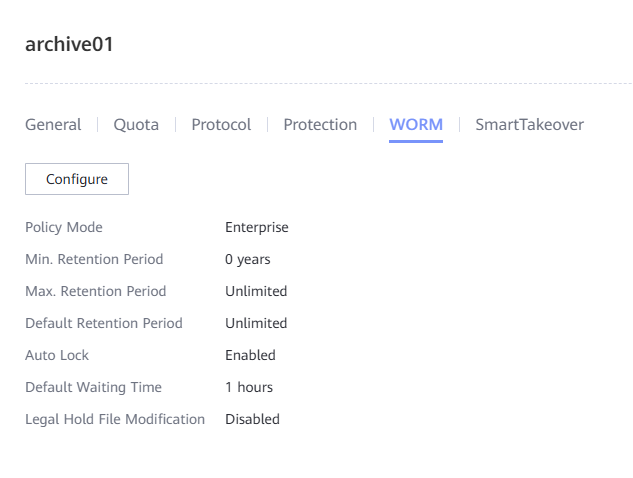 2. In step 2, the file fails to delete and modify. Current file has 3 version, the first version is created before 1 hour, sceond version in 1 hour. 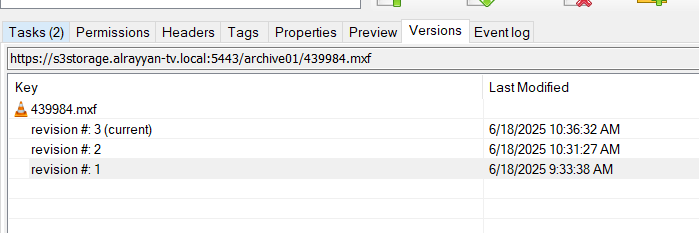 It fails when delete the first version.  It successfully delete the second versoin because it update in 1 hour.   |
Test conclusion | Successful |
Remarks | After worm function enabled, the file can delete in waiting time but cannot delete or change after waiting time, it will be locked by storage. |
2.1.12 Object Versioning function test
Test Purpose | Verify that the object service supports the versioning function which implements logical protection for object data and quickly restores abnormal data using backup data. |
Test Networking | Basic Verification Networking |
Prerequisite | 1. The storage system is running properly. 2. The object service has been initialized on DeviceManager. 3. An object protocol host has been prepared. 4. Test account version has been created and its AK has been recorded. |
Test Procedure | 1. Use S3 Browser and account version to create bucket. 2. Use S3 Browser to enable the versioning function for bucket. 3. Use Dalet to delete and upload one existing object in the bucket. 4. View the objects with the same name uploaded at different time. |
Expected Result | 1. In step 1, the bucket is created successfully. 2. In step 2, the versioning function is enabled successfully for the bucket. 3. In step 3, the objects are deleted and uploaded successfully. 4. In step 4, you can view the objects of different versions in the bucket. |
Test result | 1. In step 1 and 2, the bucket is created successfully and the versioning function is enabled successfully for the bucket.  2. In step 3, the objects are deleted and uploaded successfully. 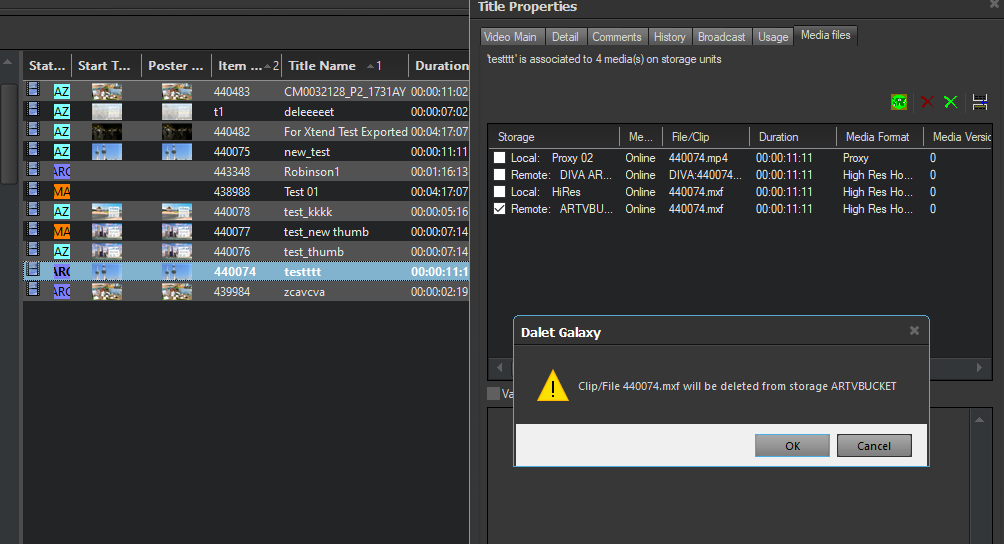 3. In step 4, you can view the objects of different versions in the bucket. 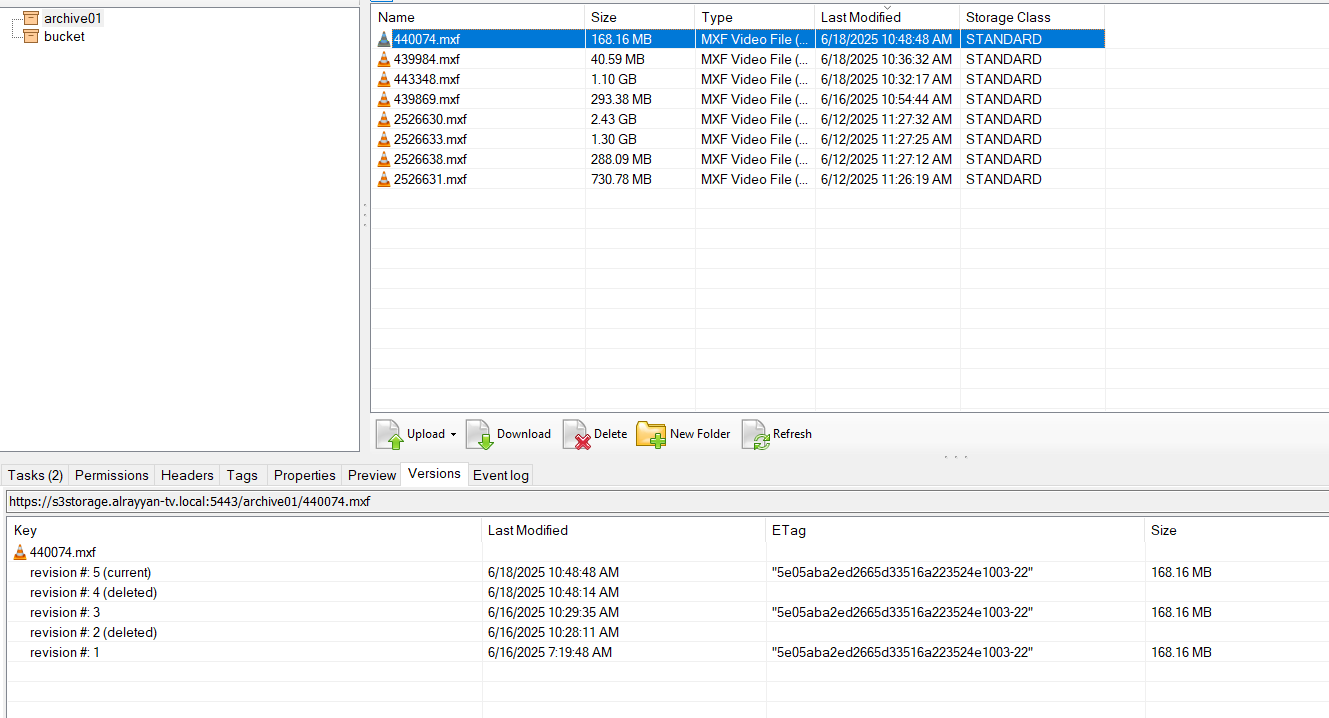 |
Test conclusion | Successful |
Remarks | After Pacific Object storage enabled Versioning, Dalet can delete object but it will not really delete, it will show as deleted version, and you can upload with same name to get new version. |
2.2 Ultra-HD TV Program Service Performance Test
2.2.1 CIFS 100 Mbit/s HD Video Stable Bandwidth Test
Test the number of stable HD video layers. | |
Test Networking | Test network diagram |
Prerequisite | 1. The distributed storage system has been configured and EC is set to EC4+2:1. 2. Configuring File Share 3. The server has two 10GE network ports and SMB MultiChannel is enabled. The client has two 10GE network ports and SMB MultiChannel is enabled. The network between the client and the server is normal. 4. Configuring the Video Bit Rate on Multiple Clients (For example, the HD bit rate v = 100 Mbit/s, that is, 12.5 MB/s) and mount the storage system shared directory. |
Test Procedure | 1. Ensure that the number and configuration of the network and workstations do not become bottlenecks, continuously increase the number of ingested video tracks, and ensure that the stable bandwidth of each track is at least 12.5 MB/s. The test takes at least five minutes. 2. Record the bandwidth data of each track and the number of tracks that meet the conditions. |
Expected Result | 48-channel per node, 144-channel for three nodes |
Test conclusion | HD stable read 100-channel (tested for 100 Channels only) |
Remarks |
2.2.2 CIFS 500 Mbit/s 4K Video Stable Bandwidth Test
Test Purpose | Test the number of stable 4K video layers. |
Test Networking | Test network diagram |
Prerequisite | 1. The distributed storage system has been configured. 2. Configuring File Share 3. The server has two 10GE network ports and SMB MultiChannel is enabled. The client has two 10GE network ports and SMB MultiChannel is enabled. The network between the client and the server is normal. 4. Configuring the Video Bit Rate on Multiple Clients For example, the 4K bit rate is 500 Mbit/s, that is, 62.5 Mbit/s. and mount the shared directory of the storage system. |
Test Procedure | 1. Ensure that the number and configuration of the network and workstations do not become bottlenecks, continuously increase the number of ingested video tracks, and ensure that the stable bandwidth of each track is no less than 62.5 MB/s. The test takes at least five minutes. 2. Record the bandwidth data of each track and the number of tracks that meet the conditions. |
Expected Result | 4K stable read > 50 tiers |
Test conclusion | 4K stable read 32 channels (tested for 32 Channels only) |
Remarks |
2.2.3 Average E2E I/O response latency
Test Purpose | Verify the average latency of the read and write blocks of ultra-HD video in the storage system in the test scenario. |
Test Networking | Test network diagram |
Prerequisite | 1. Set up the test environment according to the test network diagram. 2. Configuring the analog video bit rate on multiple test clients (For example, the 4K ultra-HD bit rate is 500 Mbit/s, that is, 62.5 MB/s.) and mount the storage system shared directory. 3. Set the I/O block size to 1.25 MB/s. 4. Read/Write model: 100% sequential read and 100% sequential write. 5. 50% of the storage space is used. |
Test Procedure | When the number of ultra-HD video layers required by the service user is used, read and write videos based on the configured block size, test and record the average system I/O response delay from the client thread to the storage medium. |
Expected Result | Average system I/O response latency and recorded |
Test result | 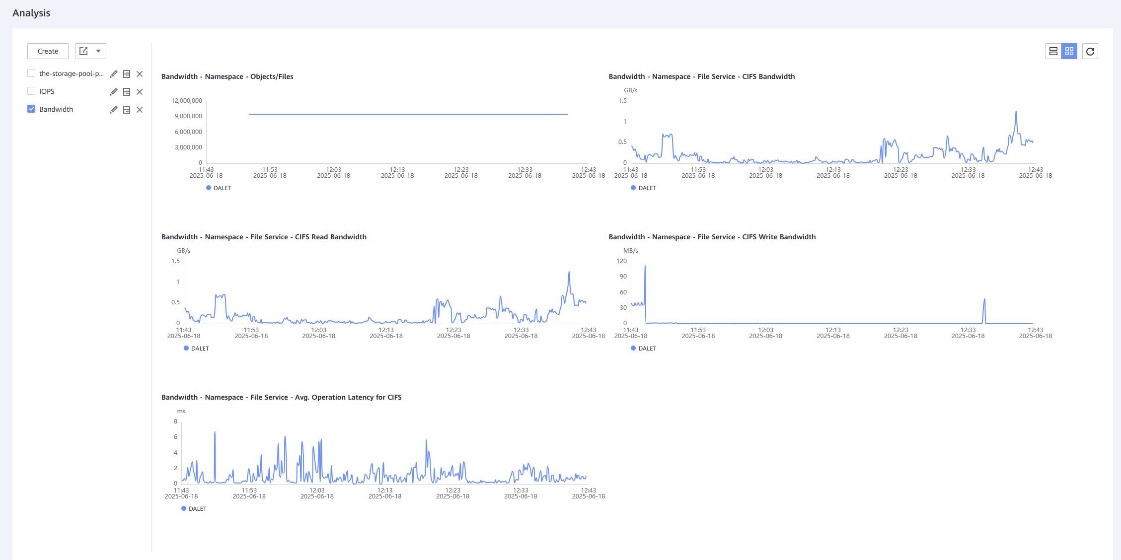
|
Test Conclusion | Average I/O response latency: 4ms |
Remarks |
2.3 Maintainability test
2.3.1 Access Log Function Test
Verify that the system can record file directories and object storage operation logs. | |
Test Networking | Test network diagram |
Prerequisite | 1. Set up the test environment according to the test network diagram. 2. The storage system has been deployed and the operation log function has been configured. 3. The Auditlog is enabled in the storage system, and a CIFS share is created for the Auditlog. The CIFS client mounts the shared directory. |
Test Procedure | 1. Create directories, create files, write files, rename files, delete files in the mounted NFS client directory. 2. Create and delete objects by using the S3 browser on the S3 client. 3. Check whether the preceding operations are recorded in the storage operation log file. |
Expected Result | In step 1, the directory file is successfully operated on the client. In step 2, the directory file is successfully operated on the client. In step 3, the object is successfully operated on the client. In step 4, the operation log file contains the logs of the preceding operations, and the records are correct. |
Actual test result | In step 4, the audit logs of NFS and object storage are displayed. 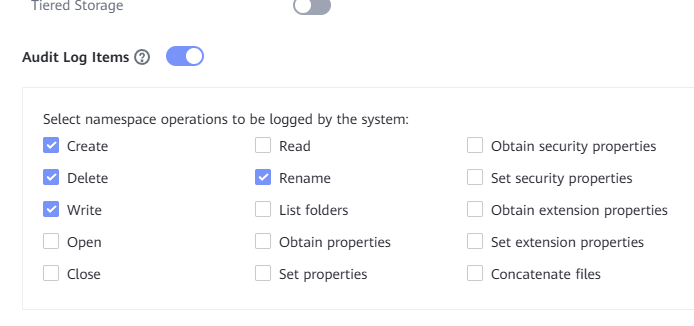  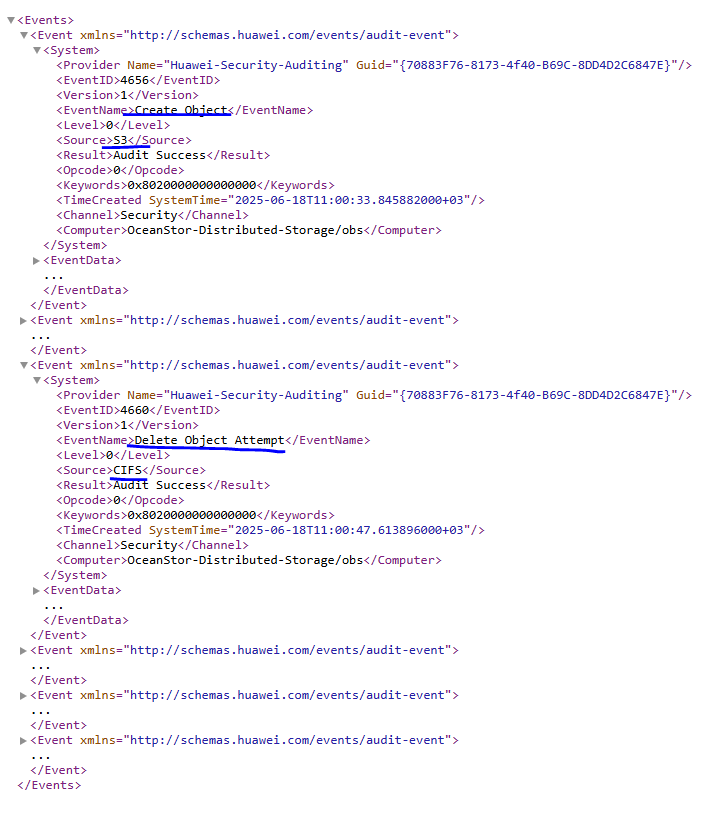 |
Test conclusion | Successful |
Remarks | After Auditlog enabled, you can monitor the selected operations from NAS and S3 protocol both. |
2.3.2 System status monitoring test
Test Purpose | Verify that the storage system can monitor and manage internal servers. |
Test Networking | Test network diagram |
Prerequisite | 1. Set up the test environment according to the test network diagram. 2. The storage system has been deployed and basic configurations have been completed and is running properly. |
Test Procedure | 1. Log in to the web GUI management platform and view the health status, running status, and capacity of the cluster. 2. Log in to the Web GUI management platform and view the performance information. 3. Simulate a fault scenario randomly on the device side. (for example, power supply removal, node removal, and disk removal). Check whether the alarms are reported on the Web GUI. |
Expected Result | 1. In step 1, the health status, running status, and capacity of the cluster are displayed. 2. In step 2, the performance can be viewed from the following dimensions: bandwidth, OPS, memory, and CPU. 3. In step 3, the alarm information is displayed and the reported alarm is consistent with the actual situation. |
Test result | 1. You can view the cluster health status, running status, and capacity, the performance is displayed, the alarm is reported.  |
Test Conclusion | Successful |
Remarks | You can easily monitor the status of storage system from WEB UI. |
